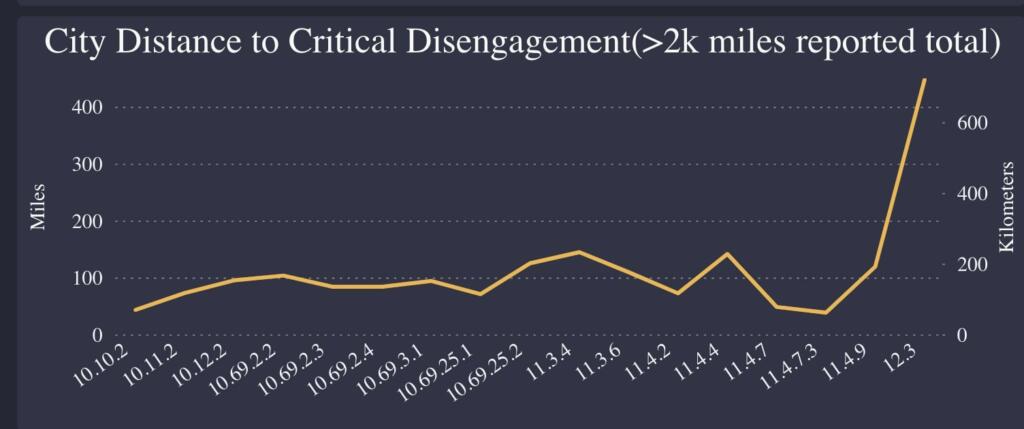Tesla FSD Tracker crowdsources data on the Tesla FSD driver experiences.
They are now recording 448 Miles between critical disengagements for Tesla FSD 12.3 Supervised. This is over three times better than the best results for any Tesla FSD v11.X and it is over four times better than any Tesla FSD v10.X.
The rate of improvement for Tesla version 12.X is happening in a few months and weeks while the 40% improvement for Tesla FSD v10.X to the last FSD v11.X was nearly three years.


The data for the later Tesla FSD v12.3.X needs some weeks to be entered. It would take a few weeks to five a few hundreds miles and to record higher distances without disengagement or with few disengagements. New FSD 12.3.X and FSD 12.4.X drivers will need to adjust and learn to have confidence in the Tesla FSD system.
It would take several months of driving for a system that actually had the ability to perform thousands of miles between interventions to have that data recorded.

Brian Wang is a Futurist Thought Leader and a popular Science blogger with 1 million readers per month. His blog Nextbigfuture.com is ranked #1 Science News Blog. It covers many disruptive technology and trends including Space, Robotics, Artificial Intelligence, Medicine, Anti-aging Biotechnology, and Nanotechnology.
Known for identifying cutting edge technologies, he is currently a Co-Founder of a startup and fundraiser for high potential early-stage companies. He is the Head of Research for Allocations for deep technology investments and an Angel Investor at Space Angels.
A frequent speaker at corporations, he has been a TEDx speaker, a Singularity University speaker and guest at numerous interviews for radio and podcasts. He is open to public speaking and advising engagements.


As long as it’s better than a human driver, it’s a winner.
So, as long as its worse than a human driver, its a loser?
https://www.reddit.com/r/SelfDrivingCars/comments/1b121z0/fsd_beta_1221_critical_disengagement_failed_to/
I don’t think critical disengagement necessary means accident.
Nevertheless the autopilot should be way, way better before we will trust it.
Tesla did a huge step back, when ditching radar. Radar gives good extra data and layer of security,… Perhaps now they will nail it, I don’t know. Companies marketing their vehicles as lvl 3 or 4 only only use limited number of them or even they advertise only 1 feature of the whole suit as level 4.
Actually no. Radar is quite noisy and needs much post processing to merge with colour video processing. These two don’t go together well
This is where broadening the base of data collection vehicles gets important. As any event that’s a noteworthy disengagement gets rare, having millions of participating vehicles becomes important to pull useful training data.
>They are now recording 448 Miles between critical disengagements for Tesla FSD 12.3 Supervised.
~20,000 miles/year for a busy driver in USA. So FSD has to be ~40X better to only have ONE CRITICAL disengagement per year and that is WAY to often. It should average about ONE Critical disengagement event per DECADE. So FSD has to get ~400X better before any sane person would trust it with their child’s life.
I don’t think that is the right interpretation, because it’s an apple to oranges comparison. I found info on waymo on Reddit claiming a cricital disengagement every 16000 miles while their accident rate is way lower then a human. So the 2 numbers don’t match. But yes it’s going to have to be much safer then now, but to give you an idea, the improvements are compounding and thus exponential not linear. A 400x improvement is 33 steps of 20% improvement or 18 steps of 40%.
Critical disengagement means major accident, not a fender rub but a ‘call the ambulance’ accident.
We fly, get on an elevator, drive over a bridge, etc. because it is so safe you can easily go your entire life and never experience a single accident with them.
FSD has to be orders of magnitude safer than a human, 10X is NOT enough. It has to be so much safer than a human driver that NOT using it would be considered deliberately driving impaired.
The current generation of children is the final one in which obtaining a driver’s license is a typical rite of passage into adulthood.
Agreed.
a 3x improvement is great, and very promising, but still a ways to go. But with the rate of improvement with their neural net, it might only be a year away from real FSD (plus regulatory bureaucracy).
Based on human driving how often should there be a critical disengagement?
Inflection point?
You don’t decide, NHSTA does. Meanwhile human drivers kill over 40,000people on average every year in the US! Look it up, please. Also, you’re demanding perfection: no company can afford to engineer those specifications. No, a system with a 10x better than human driver would get my “good start” vote. If you come up with a solution to the dangerous human driver problem, I’ll give you a strong atta boy.